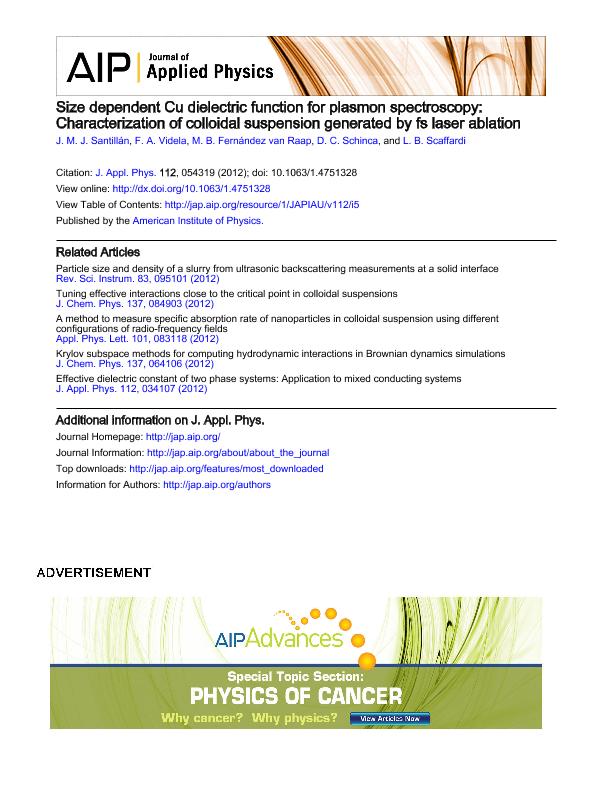Artículo
Size dependent Cu dielectric function for plasmon spectroscopy: Characterization of colloidal suspension generated by fs laser ablation
Santillán, Jesica María José ; Videla, Fabian Alfredo; Fernández van Raap, Marcela Beatriz
; Videla, Fabian Alfredo; Fernández van Raap, Marcela Beatriz ; Schinca, Daniel Carlos; Scaffardi, Lucia Beatriz
; Schinca, Daniel Carlos; Scaffardi, Lucia Beatriz
 ; Videla, Fabian Alfredo; Fernández van Raap, Marcela Beatriz
; Videla, Fabian Alfredo; Fernández van Raap, Marcela Beatriz ; Schinca, Daniel Carlos; Scaffardi, Lucia Beatriz
; Schinca, Daniel Carlos; Scaffardi, Lucia Beatriz
Fecha de publicación:
10/09/2012
Editorial:
American Institute of Physics
Revista:
Journal of Applied Physics
ISSN:
0021-8979
Idioma:
Inglés
Tipo de recurso:
Artículo publicado
Clasificación temática:
Resumen
Copper metal nanoparticles (Nps) have received increasing interest during the last years due to their potential applications in several fields of science and technology. Their optical properties depend on the characteristics of the dielectric function of the metal, their size, and the type of environment. The contribution of free and bound electrons on the dielectric function of copper Nps is analyzed as well as their influence on its plasmonic properties. The contribution of free electrons is corrected for particle size under 10 nm, introducing a term inversely proportional to the particle's radius in the damping constant. For bound electron contribution, interband transitions from the d-band to the conduction band are considered. For particles with sizes below 2 nm, the larger spacing between electronic energy levels must be taken into account by making the electronic density of states in the conduction band size-dependent. Considering these specific modifications, optical parameters and band energy values could be determined by fitting the bulk complex dielectric function. The obtained values were coefficient for bound electron contribution Kbulk = 2 × 1024, gap energy Eg = 1.95 eV, Fermi energy EF = 2.15 eV, and bound electrons damping constant γb = 1.15 × 1014 Hz. Based on the dielectric function determined in this way, experimental extinction spectra of colloid suspensions generated by ultrafast laser ablation of a solid copper target in liquids was fitted using the Drude-interband model and Mie's theory. Depending on the experimental conditions and liquid medium, the particles in the suspension may have nanometric or subnanometric core size and may be capped with a shell of oxide. From the fitting, it was possible to determine the structure and size distribution of spherical bare core and core-shell copper Nps in the nanometer-subnanometer size range. These results were compared with those obtained by standard microscopy techniques such as AFM and HRTEM. There is a very good agreement between the three techniques, showing that optical extinction spectroscopy (OES) is a good complementary technique to standard high resolution electron microscopy and AFM for sizing spherical nanometric-subnanometric Nps. OES has also the advantage of a very good measurement statistics, due to the large number of probed particles across the sample cell. Besides, it avoids coalescence effects since the measurement is made directly on the colloidal suspension.
Palabras clave:
OPTICAL EXTINCTION SPECTROSCOPY
,
OPTICAL PROPERTIES
,
BOUND STATES
,
OXIDES
Archivos asociados
Licencia
Identificadores
Colecciones
Articulos(CIOP)
Articulos de CENTRO DE INVEST.OPTICAS (I)
Articulos de CENTRO DE INVEST.OPTICAS (I)
Articulos(IFLP)
Articulos de INST.DE FISICA LA PLATA
Articulos de INST.DE FISICA LA PLATA
Citación
Santillán, Jesica María José; Videla, Fabian Alfredo; Fernández van Raap, Marcela Beatriz; Schinca, Daniel Carlos; Scaffardi, Lucia Beatriz; Size dependent Cu dielectric function for plasmon spectroscopy: Characterization of colloidal suspension generated by fs laser ablation; American Institute of Physics; Journal of Applied Physics; 112; 10-9-2012; 1-9
Compartir
Altmétricas



